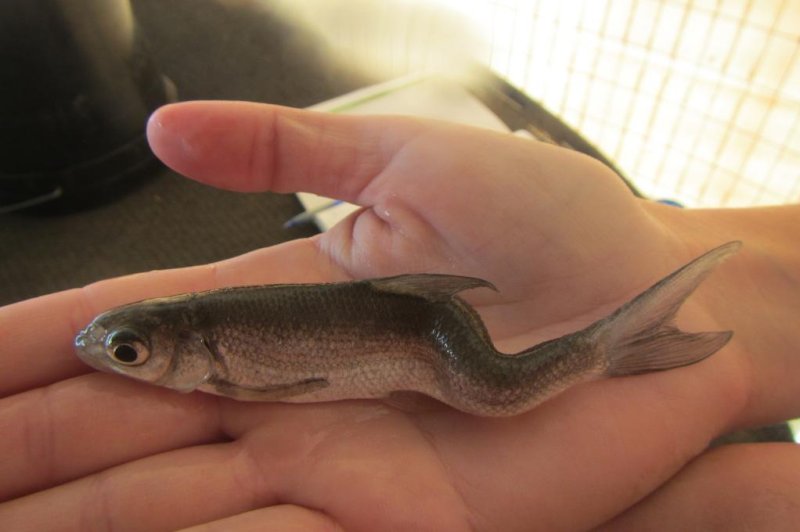
Scientists found selenium exposure was responsible for spinal deformities in juvenile Sacramento splittail, fish native to the California Delta. Photo by Fred Feyrer / U.S. Geological Survey
Feb. 24 (UPI) -- Exposure to elevated levels of the toxic mineral selenium caused fish native to the Sacramento-San Joaquin Delta, sometimes called the California Delta, to develop spinal deformities.
In 2011, biologists collected hundreds of minnows, juvenile forms of the Sacramento splittail, from the California Delta. Of the approximately 1,000 specimens studied, 80 percent had deformed spines.
"This was not just a few fish, it was the majority of them," Fred Feyrer, fish biologist at the U.S. Geological Survey's California Water Science Center, said in a news release.
Feyrer is co-author of a new study, published Monday in the journal Environmental Science and Technology, detailing the dangers of selenium exposure for fish in the Sacramento-San Joaquin Delta.
RELATED Microplastics disrupt local food chains, study finds
To pinpoint where the fish were exposed to the toxins responsible for their deformities, scientists exposed test fish to selenium in the lab and developed methods for measuring the chemical signatures trapped in layers of the minnows' ear bones, or otoliths.
"We found that the otoliths record a diary of selenium exposure from birth to death, and were the key to unraveling this mystery," said lead study author Rachel C. Johnson, a research biologist at NOAA Fisheries' Southwest Fisheries Science Center and the University of California Davis.
Using the methods they perfected in the lab, scientists used high-intensity X-rays at Cornell University's Cornell High Energy Synchrotron Source to measure selenium concentrations in the otoliths of the juvenile fish originally collected from the California Delta.
RELATED Report reveals elevated benzene levels at 10 U.S. oil refineries
The results showed the fish were exposed to selenium from their mothers and while feeding in the San Joaquin River.
"They got it from both directions," Johnson said.
Another study, published late last year in the journal Science of the Total Environment, showed adult splittail were exposed to elevated levels of selenium while feeding in the San Francisco Estuary. Scientists suspect the fish are exposed to the naturally occurring toxin while eating Asian clams. The filter feeding clams, which concentrate selenium from the river water, are a favorite food source of the splittail.
When the clam-eating splittails lay eggs, the selenium gets passed on to the next generation, leading to spinal deformities.
Researchers also previously found evidence that birds exposed to selenium concentrated in agricultural runoff suffered deformities in the 1980s.
Scientists still aren't sure of the causes of the elevated selenium levels in the Sacramento-San Joaquin Delta. The element is essential to life, but it is toxic at high concentrations. Though selenium is naturally occurring, it can also be leached from coal ash and crude oil processing, as well as mining and metal smelting.
Finding living evidence of selenium exposure is rare, as most fish exposed to the toxin quickly perish or get eaten by a predator. It's possible scientists have missed the signs of previous episodes of selenium exposure.
"Was this a one-time event?" said co-author Robin Stewart, a research hydrologist at the U.S. Geological Survey. "What we don't know is how frequently this could be happening, because no one is out there looking for these fish before they disappear."
No comments:
Post a Comment